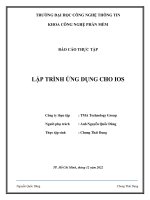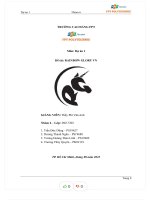a0120 apress ios wow factor nov 201 morebook vn 0129
Bạn đang xem bản rút gọn của tài liệu. Xem và tải ngay bản đầy đủ của tài liệu tại đây (839.11 KB, 7 trang )
BOOKS FOR PROFESSIONALS BY PROFESSIONALS®
et your app noticed! Find design secrets that will help your app rise to the
top and get the attention it deserves with iOS Wow Factor. Go beyond the
basics and learn where to "break the rules" to give your users the ultimate buzzworthy experience! You'll learn how to use standard and non-standard controls,
and high-impact custom interactions, to realize truly compelling app designs.
iOS Wow Factor reveals what makes a successful mobile app design and how to
apply those principles of success to your own apps. These proven techniques
will help your adoption rate increase and enable your app to gain the traction
it needs to succeed and earn a profit in the Apple iTunes App Store. You'll learn:
• The purpose and uses of the Apple iOS Human Interface Guidelines (HIG),
Available
iOS Wow Factor
G
Companion
eBook
Add the wow factor to set your
apps apart from the crowd
and what it means to you as an app designer or developer.
• How to move beyond the recommendations and guidelines of HIG and
considerations for creating a successful app.
• Techniques and methods for creating compelling apps that are easy to
use, entertaining and noticeable in a crowded marketplace.
• How to design for a capacitive touchscreen.
• Interaction design best practices.
• How to create a successful mobile app and user experience (UX).
You'll find everything you need to know to delight and amaze your future
customers inside iOS Wow Factor. Discover the secrets that will move your
apps out of the desert of mundane design and into the realm of amazing user
experiences!
iOS Wow Factor
Apps and UX Design Techniques for iPhone and iPad
Wood
COMPANION eBOOK
US $24.99
Shelve in
Mobile Computing
www.apress.com
User level:
Intermediate
Timothy Wood
Download from Wow! eBook <www.wowebook.com>
For your convenience Apress has placed some of the front
matter material after the index. Please use the Bookmarks
and Contents at a Glance links to access them.
Contents
Contents
................................................................................................................ iii
About the Author .................................................................................................... iv
About the Technical Reviewer........................................................................... v
Acknowledgments ................................................................................................... vi
Introduction............................................................................................................... vii
Chapter 1: Putting the iOS Human Interface Guidelines in Context ........... 1
Chapter 2: Deconstructing the iOS User Experience ....................................... 7
Chapter 3: User Experience Differentiation and Strategy ............................. 31
Chapter 4: The Killer App ..................................................................................... 45
Chapter 5: Leveraging iOS Capabilities for Optimal User Experience ....... 59
Chapter 6: Interaction Modeling and the Creation of Novel
Concepts ............................................................................................ 69
Chapter 7: Control Mapping and Touchscreen Ergonomics....................... 107
Chapter 8: Ease of Use and Feature Automation .......................................... 125
Index
...................................................................................................................... 133
CHAPTER
1
Putting the iOS
Human Interface
Guidelines in
Context
Apple’s iOS Human Interface Guidelines (HIG) aim to be the definitive starting point for designers and developers new to the platform. The company’s
approach to the guide is simple—provide a critical mass of information,
techniques, and basic methods to get an individual or development team
building applications as quickly as possible.
The guidelines set out to make the reader aware of the radically new interaction model that the platform presents. The initial challenge for Apple, when
the device was opened up for third-party application development, was to get
the platform adopted as a viable vehicle for the distribution and deployment
of applications.
At the time of Apple’s App Store launch in the summer of 2008, there was a
well-established community of specialized teams focused on mobile devices
and consumer electronics that were well-positioned to migrate to this plat-
2
Chapter 1 | Putting the iOS Human Interface Guidelines in Context
form and to begin creating software for it. However, the skills and expertise
required for success were still considered a relatively niche domain. Apple
needed a much broader base of development teams populating the App Store
with great software in order for their strategy to succeed.
Looking Back
Before 2008, mobile applications were a somewhat primitive affair—at least
by today’s standards. This was not due to any lack of trying on the part of
developers; it was because of the technological limitations imposed by devices. “Feature phones” of the era were known for their portability, with
small size being among the top criteria for success. Subsequently, these devices had very small displays with both low bit-depth color support and low
resolution for their scale. Processor capability and memory availability were
other significant constraints. This meant that the design of a mobile application was an exercise in minimalism and restraint. In that environment, the
expectations for what a mobile application could be, how it would work, and
what it looked like were not very high. Market fragmentation presented its
own set of challenges as well, driving designers and developers to target a
lowest common denominator of input and display to ensure success across a
large variety of devices. This approach contributed significantly to a suboptimal user experience for applications running on those devices.
“Smartphones” presented a different set of challenges. They usually had
larger, higher-quality screens and much greater computational capacity.
However, these devices often had unique input characteristics that varied
significantly from manufacturer to manufacturer. Some of the more prevalent
forms of input included
Jog dials
Four- and five-way controllers
Dedicated buttons or hard keys
Variable buttons or soft keys
Stylus input
Touch input
A given device incorporated any combination of these controls as a part of its
design. In many cases the nature of the input was considered a “signature in-
Introduction
It’s a tough market out there, and as I’m sure you know, it can be very difficult for your application to get noticed in the App Store. There are literally
hundreds of thousands of both interesting and not so interesting applications available for download now. Just having a highly functional and stable
application from a development perspective isn’t enough to get your app the
recognition it needs to go mainstream. Users expect to be ‘Wowed’ with
their iOS apps, this is probably something that you have experienced yourself. As you probably know, it’s the ‘Wow Factor’ of that initial app experience that sets the hook and gets users engaged with the features and functions that you or your development team have been working so hard to
create. It’s ‘Wow Factor’ that gets you world of mouth recommendations
between friends and great reviews in the app store. It’s ‘Wow Factor’ that
can drive the viral adoption of the application that ends up funding your early retirement! The big question is, what is Wow Factor, and how do you
get it?
Those are not easy questions to answer, but the good news is that there
are answers, and I certainly will address those later in this book - but you
need to know that you can get to ‘Wow’ if you are willing to start paying
close attention to the details of your application experience. There’s no
doubt about it, critical thinking, excellent problem solving skills, and solid
design methods are behind any great user experience. Elevating your design
practice to a higher level is absolutely necessary to get that ‘Wow’ that you
are looking for, and that’s at the heart of what this book is about. But
‘Wow’ takes more than good design practice. It’s also rooted in how you
think about, or frame up your design problems and that requires a greater
understanding of the wider context for the design decisions you are going
to make.
It’s my firm belief that you can’t truly know where you are going without a
good understanding of where you have been. The iPhone isn’t the first
vii
INTRODUCTION
smartphone to appear in the market, although it is one of the most successful and influential. As an application designer, or developer, you understand
at some level the huge opportunity this new platform presents and obviously you’d like to take advantage of it. By looking into the past we can understand why the iPhone is the way it is and why it is held up as a shining beacon of great user experience.
As you think about your application, you may need to build upon some of
the fundamental concepts behind that experience the core experience of
iOS, but on the other hand, you may just want to toss them aside. The idea
behind this book is fairly simple, to give you, designer and developer, practical insights into the nature of the iOS user experience, while empowering
you with information to create your own exceptional applications. For many
people, Apple’s Human Interface Guidelines is the starting point for understanding the possibilities that iOS enables for users. But what do you do if
you need to go beyond those rudimentary guidelines? Because they are just
that, rudimentary - and that’s just not going to cut it for you! This book
intends to help push you beyond the basic assumptions you may have about
iOS applications provide you with the ideas and techniques that will help
you build upon your own insights and free your personal creativity.
Creating a successful iOS application isn’t easy, but it’s my hope that this
book will help you take your application to the next level and help it get the
attention that it deserves.
viii









